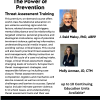Mind Hunter – Inside the FBI’s Elite Serial Crime Unit
$4.99-John Douglas
384 pages, published in 1995.
Summary: Mind Hunter describes the distinguished career of former F.B.I. agent John Douglas. The text follows Douglas from the beginning of his F.B.I. career, through the pionering of criminal profiling and the forming of the F.B.I.’s Behavioral Science Unit. Douglas describes the infamous cases he was involved with, as well as, the profiling techniques he helped pioneer. He discusses the serial offenders that he interviewed over the years. Their methods, techniques and their motivation for the commission of their offenses. Perhaps most importantly, Douglas helps the reader to begin to make sense of the horrendous nature of the crimes of serial killers.
Comments: This text would best be described as a memoir. One that goes into great length to describe the final output of one law enforcement agent’s outstanding career dealing with and attempting to understand the nature of the serial offender. I found it to be a very fascinating read. (STS staff)
























